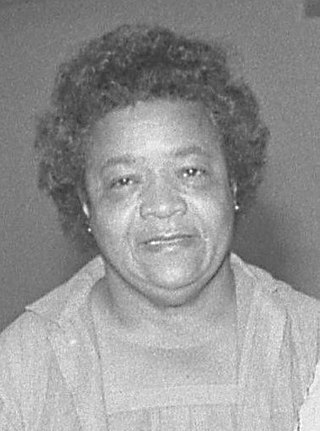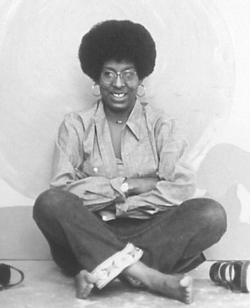
The Studio Museum in Harlem is an art museum that celebrates artists of African descent. The museum is located at 144 West 125th Street between Adam Clayton Powell Jr. Boulevard and Lenox Avenue in the Harlem neighborhood of Manhattan, New York City, United States. Founded in 1968, the museum collects, preserves and interprets art created by African Americans, members of the African diaspora, and artists from the African continent. Its scope includes exhibitions, artists-in-residence programs, educational and public programming, and a permanent collection. The museum building was demolished and replaced in the 2020s; a new building on the site is to open in 2025.
Lowery Stokes Sims is an American art historian and curator of modern and contemporary art known for her expertise in the work of African, African American, Latinx, Native and Asian American artists such as Wifredo Lam, Fritz Scholder, Romare Bearden, Joyce J. Scott and others. She served on the curatorial staff of the Metropolitan Museum of Art, the Studio Museum in Harlem, and the Museum of Arts and Design. She has frequently served as a guest curator, lectured internationally and published extensively, and has received many public appointments. Sims was featured in the 2010 documentary film !Women Art Revolution.

Samella Sanders Lewis was an American visual artist and art historian. She worked primarily as a printmaker and painter. She has been called the "Godmother of African American Art". She received Distinguished Artist Award for Lifetime Achievement from the College Art Association (CAA) in 2021.
“Art is not a luxury as many people think – it is a necessity. It documents history – it helps educate people and stores knowledge for generations to come.” – Dr. Samella Lewis
Squeak Carnwath is an American contemporary painter and arts educator. She is a professor emerita of art at the University of California, Berkeley. She has a studio in Oakland, California, where she has lived and worked since 1970.
Thelma Golden is an American art curator, who is the Director and Chief Curator of The Studio Museum in Harlem, New York City, United States. She is noted as one of the originators of the term post-blackness. From 2017 to 2020, ArtReview chose her annually as one of the 10 most influential people in the contemporary art world.
Gale Fulton Ross is an African-American visual artist who lives in Sarasota, Florida. Primarily a painter, she also practices portraiture, printmaking, and sculpture.
Betty Blayton was an American activist, advocate, artist, arts administrator and educator, and lecturer. As an artist, Blayton was an illustrator, painter, printmaker, and sculptor. She is best known for her works often described as "spiritual abstractions". Blayton was a founding member of the Studio Museum in Harlem and board secretary, co-founder and executive director of Harlem Children's Art Carnival (CAC), and a co-founder of Harlem Textile Works. She was also an advisor, consultant and board member to a variety of other arts and community-based service organizations and programs. Her abstract methods created a space for the viewer to insert themselves into the piece, allowing for self reflection, a central aspect of Blayton's work.

Joyce J. Scott is an African-American artist, sculptor, quilter, performance artist, installation artist, print-maker, lecturer and educator. Named a MacArthur Fellow in 2016, and a Smithsonian Visionary Artist in 2019, Scott is best known for her figurative sculptures and jewelry using free form, off-loom beadweaving techniques, similar to a peyote stitch. Each piece is often constructed using thousands of glass seed beads or pony beads, and sometimes other found objects or materials such as glass, quilting and leather. In 2018, she was hailed for working in new medium — a mixture of soil, clay, straw, and cement — for a sculpture meant to disintegrate and return to the earth. Scott is influenced by a variety of diverse cultures, including Native American and African traditions, Mexican, Czech, and Russian beadwork, illustration and comic books, and pop culture.
Maren Hassinger is an African-American artist and educator whose career spans four decades. Hassinger uses sculpture, film, dance, performance art, and public art to explore the relationship between the natural world and industrial materials. She incorporates everyday materials in her art, like wire rope, plastic bags, branches, dirt, newspaper, garbage, leaves, and cardboard boxes. Hassinger has stated that her work “focuses on elements, or even problems—social and environmental—that we all share, and in which we all have a stake…. I want it to be a humane and humanistic statement about our future together.”
Dale Brockman Davis is a Los Angeles–based African-American artist, gallerist and educator best known for his assemblage sculpture and ceramic work that addresses themes of African American history and music, especially jazz. Along with his brother, artist Alonzo Davis, he co-founded Brockman Gallery in Leimert Park. Through the gallery and his broader community work, Davis became an important promoter of African-American artists in Los Angeles.
Betty Nobue Kano is a Japanese painter, curator and lecturer at San Francisco State University and New College of California, teaching the 332 Japanese American Art and Literature class. She is notable for exhibiting her work in nearly 200 regional, national and international galleries and museums, including the Museum of Modern Art in San Francisco.

Suzanne Jackson is an American visual artist, gallery owner, poet, dancer, educator, and set designer; with a career spanning five decades. Her work has been exhibited in museums and galleries around the world. Since the late 1960s, Jackson has dedicated her life to studio art with additional participation in theatre, teaching, arts administration, community life, and social activism. Jackson's oeuvre includes poetry, dance, theater, costume design, paintings, prints, and drawings.
Sadie Barnette, is an American artist who works primarily with drawing, photography, and large-scale installation. Her work explores Black life, personal histories, and the political through material explorations. She lives in Oakland, California.
Brenna Youngblood is an American artist based in Los Angeles who is known for creating photographic collages, sculpture, and paintings. Her work explores issues of African-American identity and representation.
Alvia J. Wardlaw is an American art scholar, and one of the country's top experts on African-American art. She is Curator and Director of the University Museum at Texas Southern University, an institution central to the development of art by African Americans in Houston. She also is a professor of Art History at Texas Southern University. Wardlaw is a member of the Scholarly Advisory Council of the National Museum of African American History and Culture, and co-founded the National Alliance of African and African American Art Support groups in 1998. Wardlaw was University of Texas at Austin's first African-American PhD in Art History.
Dewey Crumpler, is an American painter and educator. He taught at the San Francisco Art Institute (SFAI) for many years, where he held the title of associate professor.
Julie Crooks is a Canadian curator, researcher and instructor. She has been the head of the department of Arts of Global Africa and the Diaspora at the Art Gallery of Ontario since its founding in 2020.

Susan Landauer (1958–2020) was an American art historian, author, and curator of modern and contemporary art based in California. She worked for three decades, both independently and as chief curator of the San Jose Museum of Art (SJMA) and co-founder of the San Francisco Center for the Book. Landauer was known for championing movements and idioms of California art, overlooked artists of the past, women artists, and artists of color. She organized exhibitions that gained national attention; among the best known are: "The San Francisco School of Abstract Expressionism", "Visual Politics: The Art of Engagement", and retrospectives of Elmer Bischoff, Roy De Forest, and Franklin Williams. Her work was recognized with awards and grants from the International Association of Art Critics, National Endowment for the Arts and Henry Luce Foundation, among others. Critics, including Roberta Smith and Christopher Knight, praised her scholarship on San Francisco Abstract Expressionism, De Forest, Richard Diebenkorn, and Bernice Bing, among others, as pioneering. In 2021, Art in America editor and curator Michael Duncan said that "no other scholar has contributed as much to the study of California art". Landauer died of lung cancer at age 62 in Oakland on December 19, 2020.

Ruth Tunstall Grant (1945–2017) was an African American artist, educator and activist in the San Francisco Bay Area known for her paintings, community activism, and arts advocacy. Her work has been featured in many invitational group exhibitions as well as solo shows at national and international venues such as Dallas Museum of Fine Art, Dallas, Texas; Rath Museum, Geneva, Switzerland; Triton Museum of Art, Santa Clara, California; San Jose Museum of Art, San Jose, California; and Los Gatos Museum of Art, Los Gatos, California. She had a strong focus on community service and advocacy of children’s rights and social justice in and beyond Santa Clara County. She established many innovative, ongoing arts programs and inspired creative activists, such as Marita Dingus.
Geraldine McCullough (1917–2008) was an African American painter, sculptor and art professor. She was best known for her mostly abstract large-scale metal sculpture.





